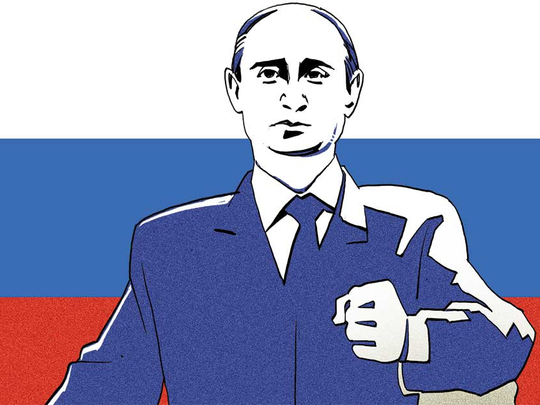
Russia’s recent summit in Astana over Syria is interesting more for its international implications rather than for any hope of bringing good news to the people of Syria. The summit included Turkey and Iran, with assorted Syrian groups while Russia uses the Syrian crisis to muscle its way back into being treated like a superpower after more than 20 years of what President Vladimir Putin sees as humiliation by the West, coupled with betrayed promises.
Russia has made a considerable effort to fall in line with Iranian objectives so as to keep them as an ally as Moscow starts its first diplomatic offensive in the Middle East in decades. The Russians have gone out of their way to recognise Iran’s positive contribution to successive Russian issues, as Mark Katz lists in the Wall Street Journal.
“Russian observers express appreciation for Iran cooperating with Moscow to negotiate an end to the Tajik civil war in the 1990s instead of supporting the opponents of the Kremlin-backed post-Soviet regime there. And unlike certain Arab countries, Iran did not support the Chechen rebels. The desire to maintain good relations with Moscow as well as the fear that Chechen secession would inflame secessionist movements inside Iran were far more important to Tehran than solidarity with fellow Muslims (especially ones who are Sunni),” writes Katz.
These historic episodes could easily have been forgotten, but Russia makes a point of mentioning them as it works with Iran to support Syrian President Bashar Al Assad, who was clearly losing the civil war at one stage. But now Al Assad is dictating negotiating terms to the divergent opposition groups, which puts him in a good place to dictate the eventual peace terms.
The Russian-Iranian-Turkish talks have marginalised the Geneva Process where the United Nations, the European Union, Saudi Arabia, along with many other Arab states, have tried to set up an inclusive framework to manage a ceasefire and bring a long-term end to the civil war. The leaders of the Syrian opposition delegation who were allowed to go to Astana represented 12 factions and claimed that Moscow genuinely wanted to move to a neutral stance, but was being held back by the Iranian and Syrian governments.
This question is very important to anyone who wants peace in Syria and who has put his or her faith in the Astana talks, but it does not really matter to the Russians. They have built a close alliance with the regime, and so are in a good position to keep their warm-water naval base on the Syrian coast in Tartus, which is in the heartland of Al Assad’s Alawite supporters, who will remain friendly to Russia regardless of what happens in the rest of Syria.
The whole Syrian adventure gives Russia an important breakout that suits Putin’s strategy to move beyond Russia’s borders and rebuild a Soviet-style sphere of influence. Putin has followed this plan for some time, as Russian forces recognised the breakaway of the provinces of Abkhazia and South Ossetia from the state of Georgia in 2008, the invasion and annexation of the Ukrainian territory of Crimea in 2014, flowed by the destabilisation of a large part of east Ukraine, which continues to today.
‘Red line’
The western response has been confused from the start, similar to what happened in Syria in 2013 when Obama failed to enforce his ‘red line’ that required Al Assad not to use chemical weapons on his people. When such weapons were used, the US was stumbling into a confused confrontation in Syria, when the Russians offered to take over and created a framework for elimination of Syrian chemical weapons that allowed Al Assad to claim that they had all been eliminated within a year.
Similar western confusion dominated the end of the Cold War and is the real reason that Putin and his administration in Russia have such a suspicious view of Nato and any American strategic thinking.
In 1989, the Berlin Wall came down, but what happened next was not planned at all. Some Nato leaders opposed the reunification of Germany. The then German chancellor Helmut Kohl wanted a reunited Germany, but the administration of the then US president, George H.W. Bush, spoke of a democratic but demilitarised East Germany that would have some sort of confederation with West Germany, but would not be part of Nato. Britain’s then prime minister Margaret Thatcher and former French president Francois Mitterrand were in an unlikely accord that Germany should never reunite. All this gave some comfort to Mikhail Gorbachev and the Russians who were watching their Soviet bloc collapse in front of their eyes. And in February 1990, the then US secretary to state, James Baker, offered Gorbachev a “guarantee that Germany’s reunification would not lead to the eastward spread of the Nato military organisation”.
All this neutral thinking turned out to be hot air. Nato eventually included all of Germany, Poland, the three Baltic republics, and continued to move ever east, making even the dimmest Russian general aware that Russia was being surrounded by its enemies. Given Russia’s understanding that the Partnership for Peace with Nato was nonsense, Putin proceeded to reignite Russian belief in itself as a Great Power. That is the real reason why his officials were in Astana making common cause with the Turks and Iranians, and those Syrians who were invited were serving a much wider purpose than their concerns.








